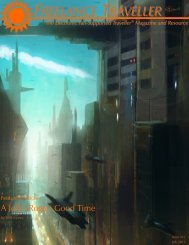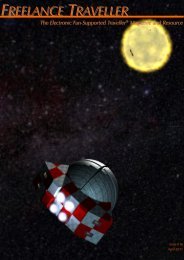Doing It My Way - Freelance Traveller
Doing It My Way - Freelance Traveller
Doing It My Way - Freelance Traveller
Create successful ePaper yourself
Turn your PDF publications into a flip-book with our unique Google optimized e-Paper software.
<strong>Doing</strong> <strong>It</strong> <strong>My</strong> <strong>Way</strong><br />
(Continued from page 27)<br />
make more. Also, grey goo would turn things into<br />
dust, rather than into more grey goo. As a result,<br />
this nanotechnology cannot render a planet, or even<br />
a city lifeless.<br />
You could have items like a canteen-sized generator<br />
that could create a fancy tent or even a small<br />
cabin and all the furnishings as the ultimate in<br />
camping gear. Also, another device might create a<br />
nanotechnology-based space suit that could transform<br />
into either combat armor or fancy dress clothing<br />
in less than a minute and requires only a tangerine-sized<br />
generator to keep this suit working and<br />
repaired. The economy of a setting with this sort<br />
of technology would look much like the previous<br />
version, except that devices (and people) could be<br />
made self-repairing using implanted nanites generators,<br />
and nanotech weapons would be hideously<br />
deadly.<br />
Advanced Nanotechnology<br />
This type of highly advanced nanotech can both<br />
self-assemble and resist bacteria. So, not only<br />
could a variety of nanite build a house, it can also<br />
make more nanites like itself, eliminating the need<br />
for nanotech generators. Utility fog and grey goo<br />
are possible, as is carrying a nanotech seed in your<br />
pocket that you can plant in a supply of the appropriate<br />
raw material to grow a spaceship, a city, or a<br />
living adult horse. The only limitation is that a<br />
horse would take a day or two to produce and creating<br />
a city would take almost a year. Most people<br />
would have extensive nanotech living inside them,<br />
and a few people might effectively be living, walking<br />
clusters of nanotech. This is god-tech territory<br />
and IMHO is not suitable for gaming as anything<br />
other than strange alien artifacts and exotic worlds<br />
that the PCs visit briefly. Instant healing and growing<br />
skyscrapers in a hour are both still impossible,<br />
because physical laws dictate that they are (because<br />
of problems with processing speed and heat dissipation)<br />
but a single vial of nanotech could still kill<br />
an unprotected planetary biosphere in a few years.<br />
Nanotechnology In The Imperium<br />
I‘d allow all three types of nanotechnology in<br />
<strong>Traveller</strong>, but would limit them greatly by TL.<br />
Limited Nanotechnology is developed at TL 12 and<br />
Moderate Nanotechnology is developed at TL 16.<br />
Perhaps one of the reasons that Darrian TL 16<br />
ships are so much in demand is that they are selfrepairing<br />
because various nanotechnology generators<br />
are built into their ships. Advanced Nanotechnology<br />
is only developed at TL 20, and thus only<br />
exists as a few rare, poorly understood, and often<br />
exceptionally dangerous artifacts, most of which<br />
were made by the Ancients.<br />
In this version of the Imperium, most goods on<br />
TL 12+ worlds are made in assembly vats. This<br />
fact need affect nothing about play in the <strong>Traveller</strong><br />
Imperium, except that every starship is likely to<br />
have several assembly vats for making spare parts,<br />
snacks, and similar oddments. If you use this type<br />
of nanotech in your <strong>Traveller</strong> campaign, it‘s worth<br />
considering that the development of TL 12<br />
nanotech may be one of the major advances that<br />
allowed the Solomani to defeat the Vilani First Imperium.<br />
Aliens<br />
Modern space opera stories take place in a universe<br />
where sophont species are relatively rare, but<br />
where both humans and aliens create modified versions<br />
of their own species using genetic engineering.<br />
Many or even most of the actual aliens that<br />
exist in these stories are not humanoid and have<br />
drastically alien cultures and physiologies. Introducing<br />
some of these touches in <strong>Traveller</strong> is relatively<br />
easy to do by introducing more obviously<br />
alien aliens, like Hivers or Vegans, while also increasing<br />
the number of aliens who are actually minor<br />
human races, or perhaps minor Vargr races or<br />
variants of other major races. For example, the<br />
Hlanssai could easily be a human (or perhaps even<br />
Vargr) minor race created by the Ancients, while<br />
the Za‘tachk and the Gurvin could easily be genetically<br />
engineered Hiver variants created 5,000 or<br />
more years ago during the Hiver‘s earliest forays<br />
between the stars.<br />
The Singularity<br />
One of the common tropes found in both modern<br />
and older space opera stories is that the galaxy<br />
(Continued on page 29)<br />
28

















